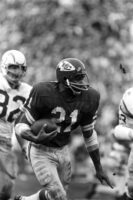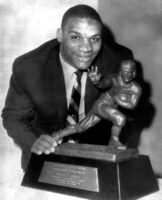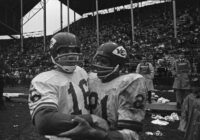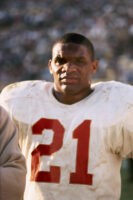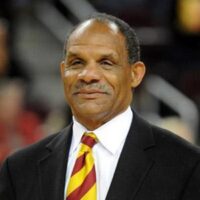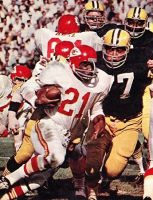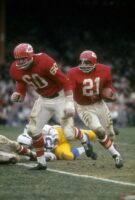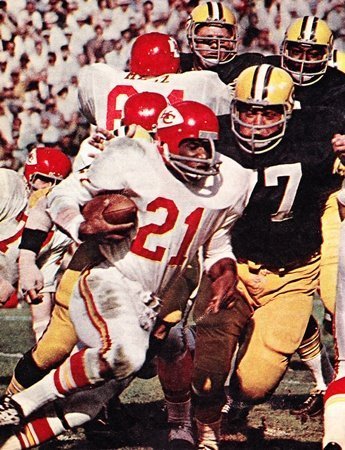Inductees
Mike Garrett

Born: April 12, 1944
It’s been deemed by the Sporting News as the most iconic play in Kansas City Chiefs history. The “65 Toss Power Trap,” ordered by coach Hank Stram and forever captured on the grainy footage of NFL Films, in essence secured the Chiefs’ Super Bowl IV victory in January 1970.
Mike Garrett, the man who scored the 5-yard touchdown on that play, beams every time he thinks about it.
“The thing I liked most about that play was Otis Taylor coming into the end zone and picking me up,” Garrett said. “We laughed because we knew what it meant. With the Jets winning the year before and then us, the AFL became equal to the NFL.”
Call it the pinnacle of his career and a big reason why the Missouri Sports Hall of Fame proudly inducted Garrett with the Class of 2018.
The 1965 Heisman Trophy winner at the University of Southern California and a 20th-round selection of the 1966 American Football League draft, Garrett enjoyed five memorable seasons with the Kansas City Chiefs (1966-1970), helping the franchise reach the first and fourth Super Bowls. Along the way, he rushed for 3,246 yards, which ranks No. 7 all-time in Chiefs history.
He later played for the San Diego Chargers (1970-1973), was inducted into three Halls of Fame – Chiefs (1978), College Football (1985), USC (1994) – and eventually returned to USC as athletic director from 1993 to 2010, hiring coach Pete Carroll in 2001 to lead a resurgence.
And he’ll always have the 65 Toss Power Trap.
“We ran it only once or twice the whole season,” Garrett said, explaining the play in great detail, that Hall of Fame quarterback Len Dawson was to fake a toss to the left but feed him the handoff to the right. Selling the fake to the middle linebackers was key. Otherwise …
“It’s a play where the running back gets destroyed by a linebacker,” Garrett said. “So when Hank called for it in the Super Bowl, I hoped that they would buy the toss, or else I’d be toast. When I slipped into the hole, their linebacker lunged at me, and I stayed away from him.”
The play pushed the Chiefs to a 16-0 advantage of an eventual 23-7 win against the Minnesota Vikings.
The TD also reinforced what Garrett had long believed – that the Chiefs should have played in each of the first four Super Bowls.
“The Chiefs were the most talented team I have played for in any sport,” Garrett said. “We were just very, very good.”
That Garrett was even playing football, no less with the Chiefs, was a story unto itself.
He had climbed out of east Los Angeles’ Roosevelt High School and into a scholarship at Southern Cal, having been noticed only because injuries to Roosevelt’s stable of running backs forced Garrett to abandon QB duties and salvage the season.
And yet he became one of college football’s greats, rushing for a whopping 3,221 yards and 30 touchdowns at USC. There, he twice earned All-American honors and launched “Tailback U” in becoming the first of USC’s six Heisman Trophy winners.
At that point, Garrett’s journey could have led to almost anywhere, such as pro baseball or the National Football League’s Los Angeles Rams. Garrett was drafted in 1965 by the Pittsburgh Pirates and twice by the Los Angeles Dodgers (1966, 1970). The Rams wanted to keep him in L.A., but wouldn’t commit to making him their No. 1 draft pick.
Plus, there was a rumor he had already signed with the AFL’s Oakland Raiders, so Garrett’s name fell in the American Football League draft all the way to the 20th round. However, the Chiefs learned the truth, and swooped in, signing him for $500,000 – or almost $3.8 million in 2017 dollars.
Not that some Chiefs were sold on him initially. Garrett was just 5-foot-9 and 191 pounds.
Fortunately, two factors played a positive role. For one, fullback Curtis McClinton as well as Emmitt Thomas, Jim Kearney and Taylor took him under their wings. Secondly, the Chiefs ran an I-formation offense familiar to Garrett, who thus earned All-AFL in 1966 and 1967.
For Garrett, now living back in Kansas City, he is thankful for wife Suzanne and their four children Sara, Daniel, Michael and John as well as USC coach John McKay and Stram, plus a memorable play.
“That was the play,” Garrett said, “that broke the game wide open.”
And defined a franchise.
